One of the many reasons why 1998 was such a groundbreaking year for gaming is Thief: The Dark Project, a game that helped invent what's now commonly referred to as the stealth action genre. Though two other noteworthy stealth action games were released that same year--Metal Gear Solid and Tenchu: Stealth Assassins--Thief's brand of stealth was the most convincing, and it went on to become the most influential. The original developer of Thief and its similar sequel is unfortunately no longer in business, but Eidos and Ion Storm thankfully snatched up the rights and have finally delivered a new chapter in the series that's suitable for longtime Thief fans and newcomers alike. Like its predecessors, the new Thief: Deadly Shadows features a memorable protagonist, a great setting, and some very interesting missions. It also happens to suffer from a variety of miscellaneous, minor flaws. These are unfortunate, since Thief: Deadly Shadows is great game, for the most part.
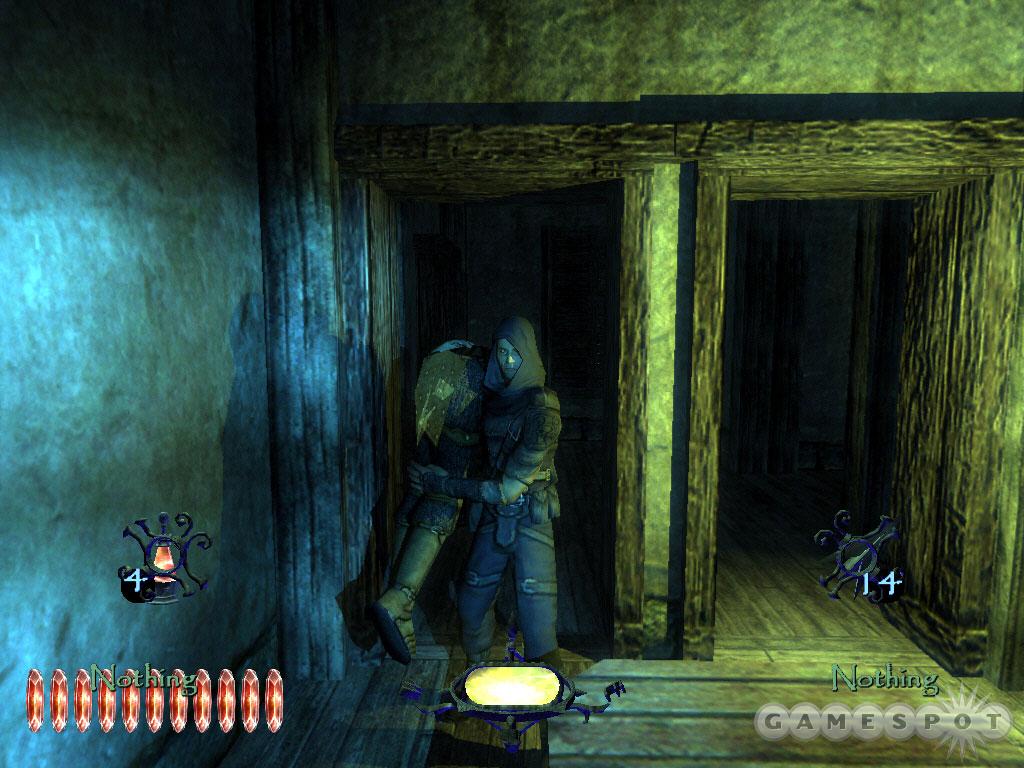
At its core, Deadly Shadows sticks very closely to the formula of the older Thief games, which are first-person perspective action adventures in which you must carry out a series of high-risk, high-reward missions as Garrett, a self-serving master thief living in a cold, surreal, medieval world. As in previous Thief games, the gameplay in Deadly Shadows primarily revolves around having to retrieve a bunch of special trinkets (and other riches) from assorted heavily guarded establishments--and doing so by hiding in shadows, waiting for unsuspecting guards to turn their backs, and then blackjacking them so that they remain unconscious for the remainder of the mission. You'll have a wide variety of other gadgets to help you, including lock picks, water arrows for dousing torches and other firelight, flashbombs for temporarily blinding opponents, and more. There's always a compass onscreen to help you navigate the sometimes mazelike environments, and you'll also be paying close attention to the onscreen "light gem," which changes color depending on how well-concealed you are. This interface feature has always worked great in the Thief series.
You'll be treated to an intriguing story, which is narrated by an even more intriguing protagonist, whose particular brand of cynicism isn't nearly as unwelcome as cynicism tends to be. The story gradually and surprisingly unfolds during the course of what's a decidedly lengthy single-player adventure. Due to the open-ended nature of the game and its four available difficulty settings, average playing time should vary quite a bit from one player to the next. However, it's safe to say you're not going to get through this one in a weekend, unless all you did was play.
The story of Deadly Shadows is gleaned through overheard conversations, cutscenes, and Garrett's own monologue, but you'll also be doing a good bit of reading memos, notes, and pages of books for clues. No previous experience with Thief is necessarily expected or required, but the plot is deeply interconnected with and contains many references to the previous games (for those who played them). For instance, the game features all of the Thief world's unique and interesting factions, including the Keepers, a shadowy group of sorcerer-scholars who once helped Garrett hone his talents; the Hammerites, religious zealots devoted to industry and order; and the weird, druidic Pagans. And while this isn't a high-fantasy world with elves and dragons, you can expect to square off against inhuman foes, like the undead, an ancient aquatic race, stone automatons, and more.
Ironically, the few detours Deadly Shadows takes from the series' blueprint are likely to annoy diehard fans of the series, while those who've never played a Thief game prior to this one will probably get caught up on issues that are, in fact, conventions of the series. As far as the annoyances are concerned, Thief fans will likely be dismayed at the absence of rope arrows in Deadly Shadows, which, in previous installments, could be used to create rope ladders, yielding access to otherwise inaccessible areas. Deadly Shadows replaces these with a pair of climbing gloves that Garrett can purchase, which are a far less interesting solution to the same types of problems. Furthermore, the climbing gloves aren't well implemented, since the mechanics of climbing feel clunky, and you rarely even need them. Lock picking has also been changed--and not for the better. Garrett will often have to pick locks, but most locks merely require you to move up, down, left, or right and then press a button to unlock from three to six tumblers. Unfortunately, this a process that can be learned quickly and neither requires nor rewards finesse. A few locks dare you to try the diagonals, but they are still completely simple to undo. As a result, this is either a perfect simulation of being a master thief, or it's just plain boring.
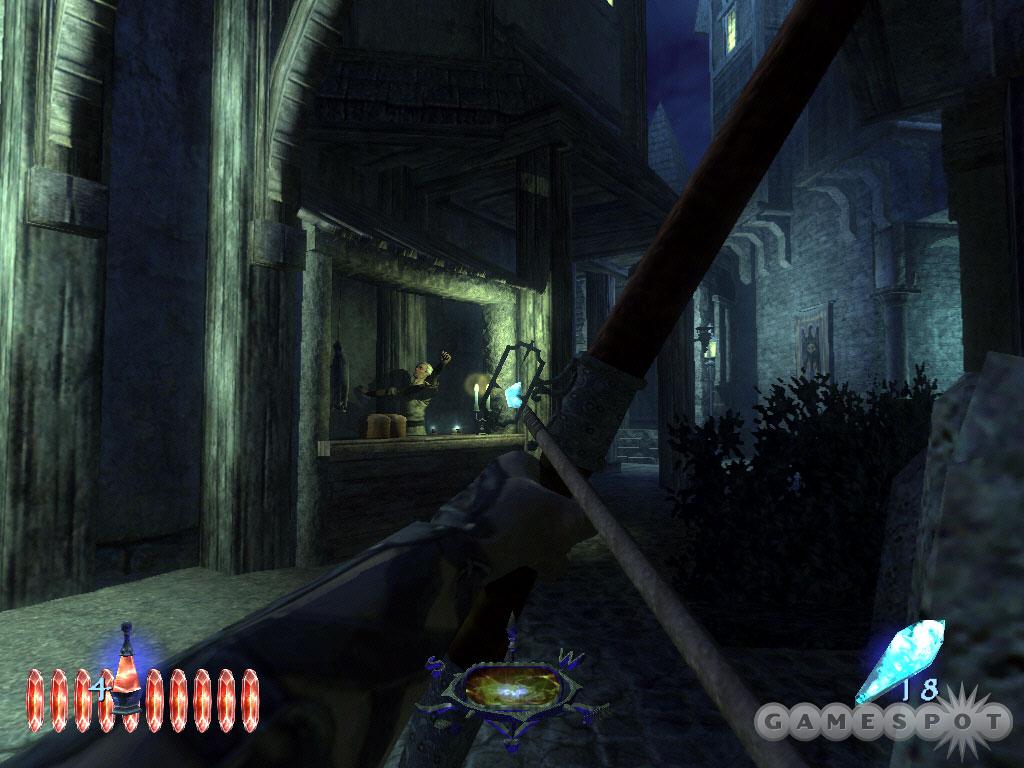
Another questionable design decision is that in Deadly Shadows, unlike in the previous Thief games, you actually get to sell all the loot you steal. You can then use these funds to purchase new equipment, which carries over from mission to mission. Let's not dwell on the ramifications of having to buy stuff from stores in a game called Thief, and let's not speculate about why a master thief like Garrett lives in a total dump of an apartment, for some reason. Instead, we'll just point out that in the previous games, your limited supply of equipment was replaced after each mission, which was a deliberate gameplay contrivance implemented to urge you to use everything at your disposal to accomplish the task at hand. By contrast, in Deadly Shadows, you'll end up hoarding your rarer items, like noisemaker arrows and fire arrows, by saving them for a rainy day that never arrives. As well, since you'll make a ton of money (being a master thief and all), you'll be able to afford a vast supply of healing potions, which are the most useful items in the game. Unfortunately, this diminishes some of the game's challenge--at least at the normal difficulty setting, in which most foes can't hurt you too much with a single attack.
Other aspects of gameplay will be very familiar to Thief fans but will take some getting used to by anyone not previously acquainted with Garrett and his world. For one thing, while you usually have access to a map of your immediate surroundings, these aren't the fancy GPS-style automaps you may be familiar with from other games. Instead, they're fairly crude, hand-drawn diagrams that aren't terribly useful. This may seem frustrating, but not only is it an authentic touch, given the pseudo-medieval setting, but also it's defensible from a gameplay standpoint, since it encourages you to actually explore the gameworld rather than spend more time looking at the map.
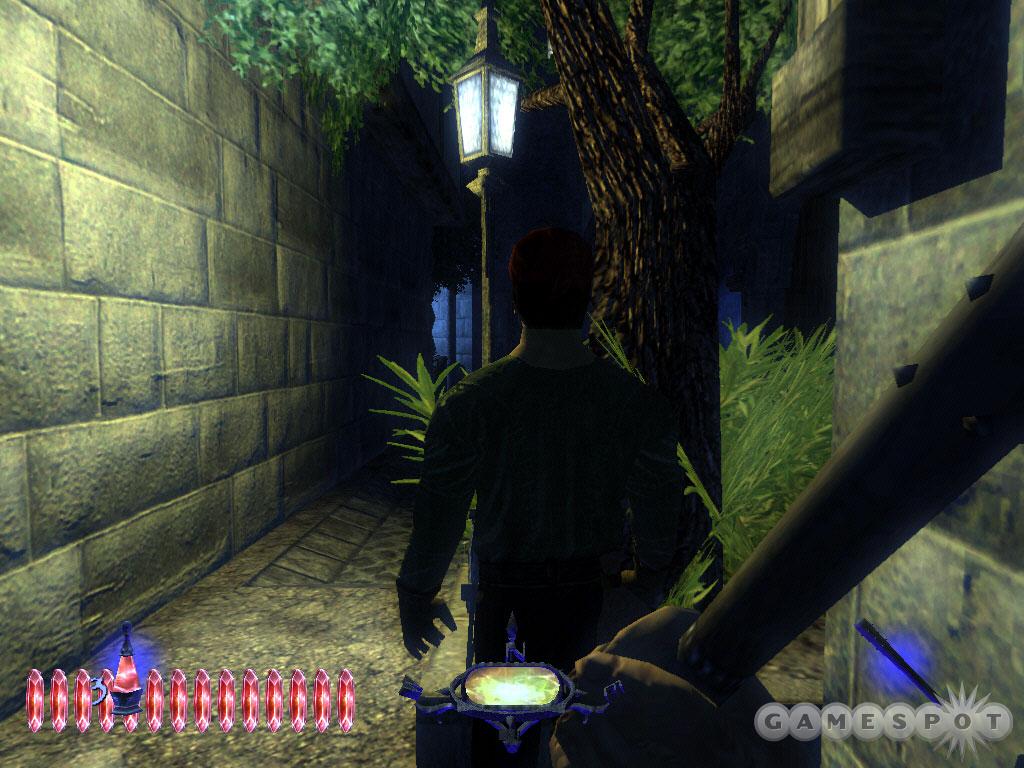
Another potential surprise is that Garrett's pretty slow, even when he's running, and he's weak in a toe-to-toe fight. It's not just him though. The game's melee combat is lousy, and it simply involves readying Garrett's dagger (which replaces his sword from the previous games) so that he can repeatedly hack at his opponent. Meanwhile, you have to hope that Garrett's opponent dies before he does. Of course, if you're playing Thief properly, then you shouldn't be going toe-to-toe with anyone anyway. You'll be spending most of your time creeping up on unsuspecting characters, and this type of action is handled very well by the game. Garrett automatically raises his blackjack or dagger when he's in range to strike, so your job is to quietly get close enough so that you can hit the button when it's time. It's a process that doesn't cease feeling risky.
The thing about Garrett is he just doesn't come across as particularly athletic. He's basically invisible when standing in shadows, but you don't ever get the feeling that you're controlling some sort of incredibly lithe and dangerous character. In short, Garrett's not a ninja. But part of the appeal of the Thief series actually stems from the fact that you really are a thief in these games, rather than a one-man army. You're quite vulnerable and have every incentive to stay out of harm's way. Other stealth action games make you feel like you could easily overpower your foes in single combat, so having to use stealth almost feels like a limitation. But in Deadly Shadows, you're often stalking things that are much stronger than you.
Staying out of harm's way actually isn't very difficult for Garrett. The entire game takes place at night, and shadows always abound, even indoors, which creates ample opportunities for sneaking around. Should you be detected, just toss a flashbomb (or a gas bomb, an explosive mine, or an oil flask) and run for the shadows. Or, if you don't want to waste a flashbomb, just run until your enemies run out of breath.
Including enemies that can run out of breath while trying to chase you is actually pretty entertaining. The enemy artificial intelligence in Deadly Shadows has a few other such neat tricks, in addition to some eventually obvious limitations. For instance, blackjacked foes fall with a groan as their weapons clatter to the ground, but in gameplay terms, all this happens silently. So if two guards are walking down a hall and they're five feet apart, you can blackjack the one at the rear, and the one at the front probably won't notice. Also, Garrett can flatten his back against walls, which is an ability that's far more useful than it should be, because it makes guards completely incapable of detecting him (in most cases). But then, guards who discover something suspicious--say, like a pool of blood or a body--will sometimes run to get some other, nearby guards to help investigate, which is a nice touch. So are the ways in which guards will notice doors that you've left open or things that have gone missing. There are also various states of alertness for guards. They might catch a glimpse of you from a distance and think nothing of it if you manage to duck out of sight quickly enough. They'll often stop and listen as you're creeping up behind them, which actually works out very nicely. You'll also hear your foes' various comments as they search for you, and despite there being some repetition in the speech, there's a lot of variety to it.
However, your foes are ultimately all alike when you've done something to arouse their suspicions. They'll search around for you for a while, and then, like clockwork, they'll put away their weapons and resume patrol--at which time you're free again to creep up on them to brain them. You can't knock out or backstab foes when their weapons are drawn, so you'll either end up waiting around for a while until the coast is clear, or you'll flee the scene and come back later. The meaty, open-ended missions in Deadly Shadows encourage exploration, so the latter approach is naturally encouraged--which is good, since in other stealth games it's often necessary to wait for alarms to stand down before you can perform other game actions. In Thief, it pays to be patient, but at least you can pretty much always keep moving and are never made to feel like you're forced through a linear trial-and-error routine.
One of the main differences between Thief: Deadly Shadows and its predecessors is another feature that may be confounding both for series diehards and new players. Specifically, the entire game, not just its missions, has a fairly open-ended structure. The City itself is the setting, and after the first two missions, you'll be relatively free to explore it in between pursuing your particular objectives. You'll be able to mug innocent passersby for their loot, avoid or attack the city watch, break into people's homes, sell your loot and buy more gear, and generally snoop around. This is a great idea, in theory. And in practice, it does help give Thief: Deadly Shadows a more cohesive feel than its predecessors or other mission-based action games. However, The City isn't all that impressive, so a better name for it might have been "The Town."
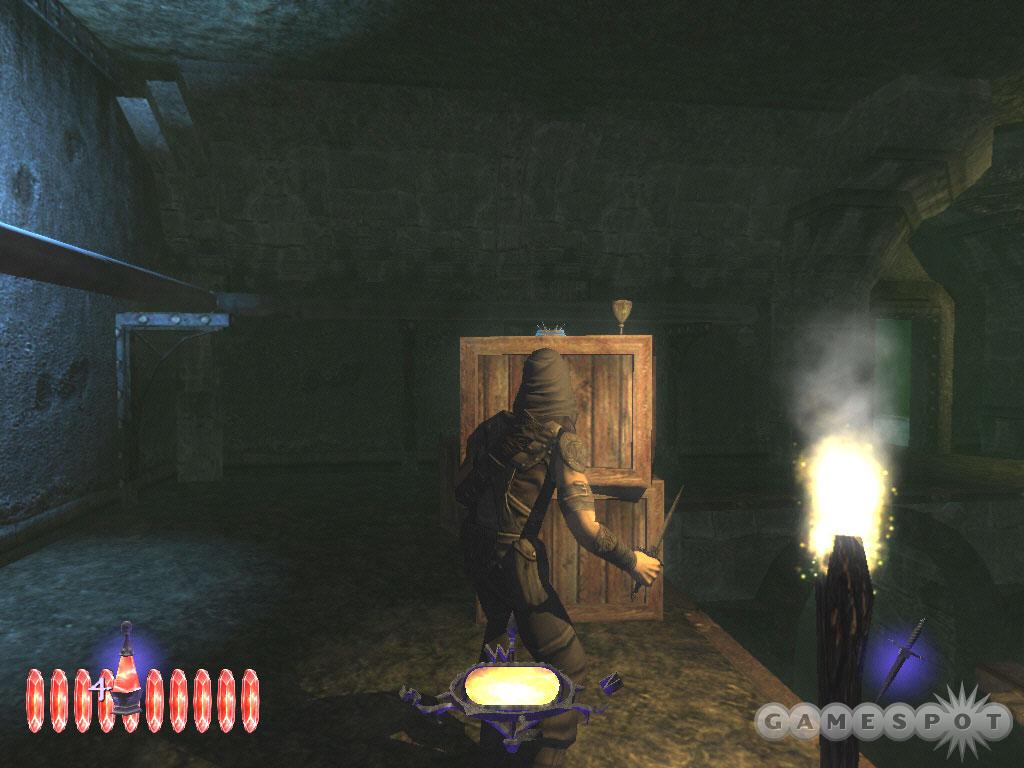
As with Ion Storm's last game, Deus Ex: Invisible War, one of the technical issues with Thief is that the game environments just don't seem big enough from one loading screen to the next. The result is that you've got these individual districts of The City that you can rush across in literally less than a minute, and each district is populated by civilians who just trudge around mindlessly. Later in the game, when you've gained access to all of The City's districts and will be required to navigate between them to complete various objectives, the going can actually get pretty tedious. It's all old hat by this point, especially with regard to the loading times. Fortunately, the mission areas feel a bit bigger, though they too tend to be split up into a couple of different zones.
Then again, the missions that make up the meat of the game are mostly excellent. Each mission has numerous objectives that must be met, which tie in with the plot. Garrett's always looking to make a little extra on the side, though, so each mission is partly a scavenger hunt for valuables. This is actually quite fun, especially when you're casing some of the game's more lavish establishments, such as a museum reported to be "thief-proof," which will be left barren, without so much as a single painting hanging on the walls, by the time you're through.
Looting is as simple as looking at the valuable and pressing a button. The loot just magically vanishes with a satisfying chime, since there's no way Garrett could realistically carry all that stuff around. Anyway, the missions are all spooky and atmospheric, and they make you feel like you truly are prowling in the dark. One remarkable mission, which takes place in a haunted orphanage-turned-asylum, is especially nerve-wracking due to its thick shadows and claustrophobic corridors. What makes the place so creepy is that it's almost entirely devoid of any living beings. Almost.
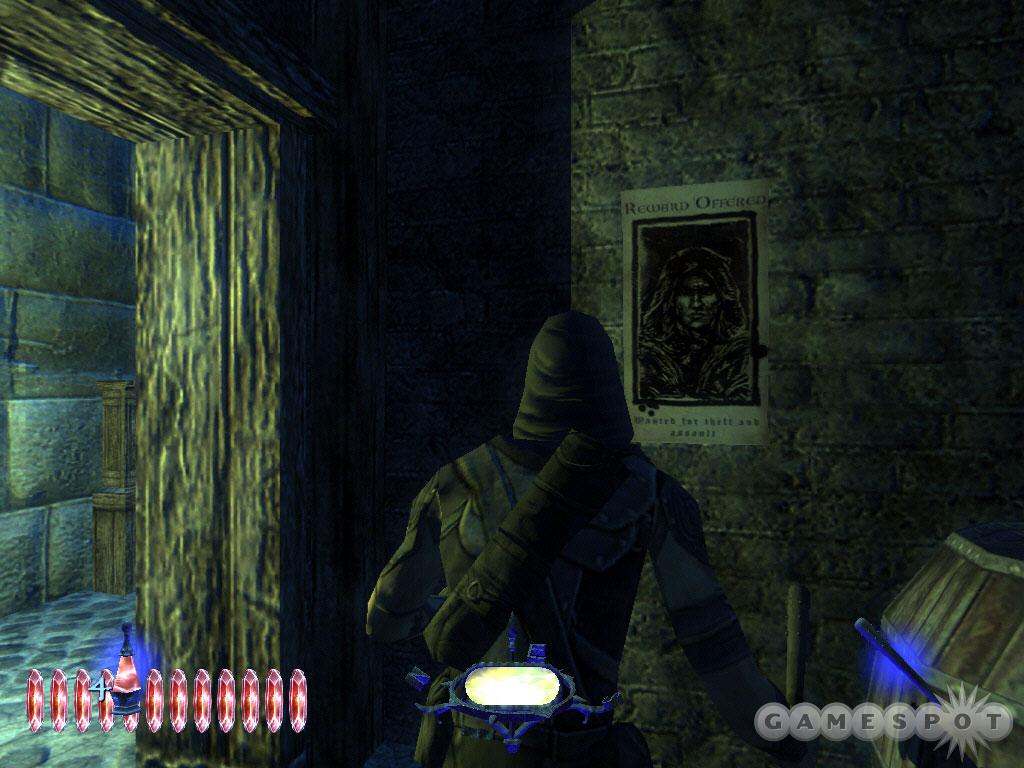
Thief: Deadly Shadows definitely has its moments, and then it has things like its artificial intelligence issues and frequent loading times. The game was developed jointly for the PC and Xbox and feels a bit out of place on both platforms, as though sacrifices needed to be made in both cases. Fans playing the PC version will wonder why the developer bothered to incorporate an optional behind-the-back, third-person perspective, which works pretty well and looks pretty good but isn't nearly as atmospheric and ultimately isn't as useful as the first-person view, which lets you see and hear the world in clearer detail. Those playing the Xbox version of the game will frown at the sluggish, often choppy frame rate, which represents an obvious compromise that was made in exchange for the dynamic lighting and other fancy special effects.
The truth is both versions of the game are comparably as good, though the PC version is ultimately the better of the two. If you have a high-end PC, you'll get better frame rates, richer colors, higher resolutions, and faster loading times than those found in the Xbox version. Additionally, you'll gain more-precise mouse-and-keyboard controls on the PC--and all for a lower retail price than the Xbox game. The Xbox version, on the other hand, guarantees acceptable graphical performance and is comparable to the PC version running at the minimum system requirements. Also, its controls are considerably more tactile, between the rumble effect that's your cue for the lock-picking sequences and having to gently move the left analog stick to make Garrett creep as opposed to run. Both versions of the game are relatively easy to pick up and play, between the conventional shooter-style controls and the helpful walk-through mission that Garrett must initially complete. Both versions let you save your progress at any point, and you must manually do so from time to time, since the game never autosaves for you.
Regardless of the platform, Thief: Deadly Shadows is a fairly impressive-looking game, thanks largely due to its lighting and shadow effects. Everything in the game looks like it has real texture to it, and in many cases, everything appears to have real mass. As a result, you can accidentally bump into barrels and boxes and other things as you sneak around, causing them to tumble down and raising a realistic racket that your opponents may actually hear. The game also uses rag-doll physics, a popular way for game artists to avoid having to create actual animations for when characters are killed or are knocked out, since they can instead let the physics take over to attempt to realistically convey the results of specific game actions. Unfortunately, in Deadly Shadows, the rag-doll effects often look silly. Bludgeoned or backstabbed characters will sometimes crane backward into a bridge, which is something that wouldn't look out of place in a yoga class but looks positively absurd here. The characters in Deadly Shadows also have a strange, plastic look to them; they move in a jittery fashion; and they reuse a lot of the same animations. The net effect is that the whole game looks like it was done in claymation, which isn't necessarily bad so much as odd. Of further note, the game's occasional animated, graphic novel-style cinematic cutscenes are mostly of very high quality and really capture the dark look and feel of the series. Some of the cutscenes are obviously more refined than others, though.
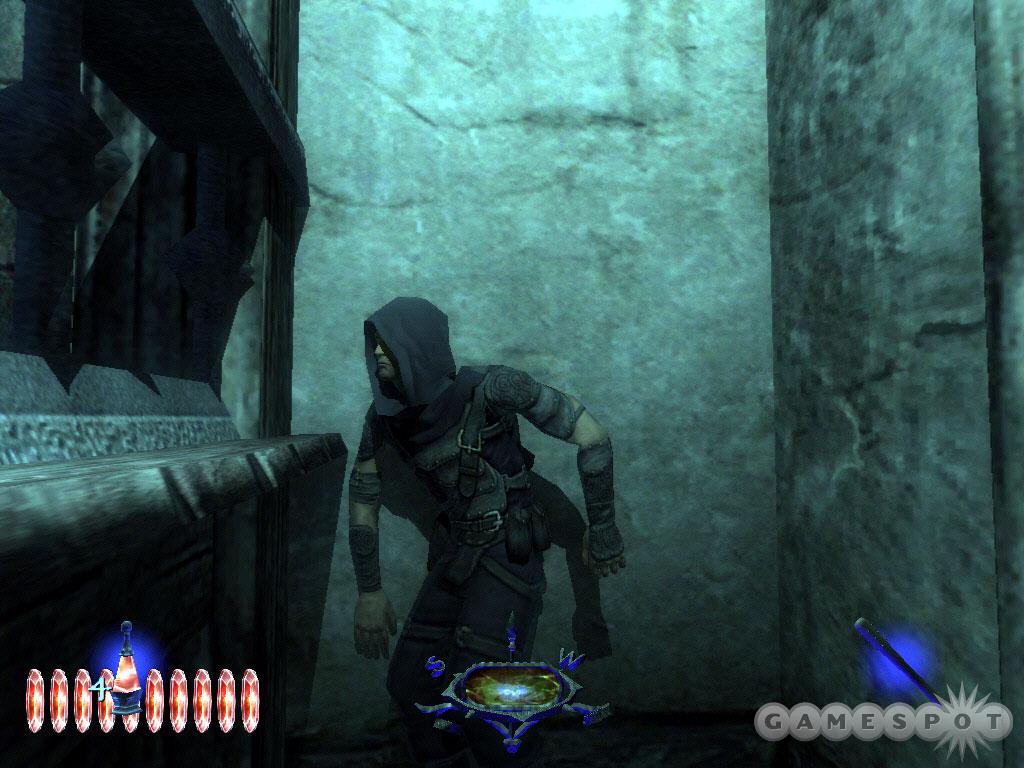
This sort of inconsistent, unpolished presentation unfortunately pervades other aspects of the game, including its audio. Fans of the series will instantly recognize Stephen Russell, who returns to provide the unmistakable voice of Garrett. Additionally, a number of other voice actors from previous Thief games again put in excellent performances. On the other hand, some of the voice-over, such as that used for some of the civilians who are walking the streets of The City, isn't nearly up to the same level of quality. That's too bad, because most of the rest of the audio is great. Deadly Shadows doesn't have much music, but the ambient effects in all the missions are downright chilling, and they heavily contribute to the game's tone and atmosphere. A few of the sounds here are recycled from previous games in the series, but most fans will probably appreciate this as a reference rather than seeing it as an easy out. Besides, these sounds are as crisp, clear, and fitting as ever.
As with Ion Storm's previous game, Deus Ex: Invisible War, this one opens itself up to a lot of criticism for being highly ambitious and attempting to be extremely believable. Deadly Shadows takes itself seriously, which is why some of the graphical and gameplay issues can seem laughable or simply disappointing, whereas the same types of things may be easily dismissed in the context of some other games. Unlike those other games, this new Thief bears the burden of being the long-anticipated sequel to a beloved series. It's possibly a self-defeating pursuit to try to recapture the creativity and innovation of the original Thief: The Dark Project by making a sequel to it. Be that as it may, the results of the effort that went into Deadly Shadows are admirable and respectable, for the most part, and they're ultimately well worth experiencing by Thief fans or by those who are sick of or those who may just be jealous of hearing about Thief fans. After all, the game could very well make one out of you.